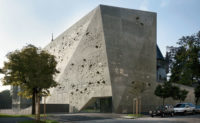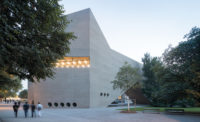Frankfurt, Germany
A hodgepodge of tightly packed additions connected to an 1878 Neo-Renaissance building by German architect Oskar Sommer, the Städel Museum dominates a stretch of cultural institutions along Frankfurt's Main River with an eclectic formality. By contrast, a recent expansion, built under the watch of director Max Hollein, is generating buzz in art and design circles for its groundbreaking approach to the seamless fusion of art, architecture, landscape, and light.
Presented with the opportunity to boost the museum's comprehensive holdings of Old Master works and modern art with contemporary pieces (including permanent loans from the Deutsche and DZ Banks), Hollein invited a select group of international architects to submit proposals that would double the existing exhibition space. The winning scheme by Frankfurt-based Schneider+Schumacher dared to go underground in order to preserve the museum's limited green space. Tucked below a popular parklike garden, the 32,000-square-foot reinforced-concrete structure is organized to follow the central axis of the original building. The architects anchored this annex to the basement of a 1921 Garden Wing and created a graceful procession with a series of elegant stairways that lead visitors up to a new event mezzanine and the subtly refurbished 19th-century lobby one floor above.
“The design had a 'wow' effect that intrigued the judges,” says Schneider+Schumacher managing director Kai Otto. “There is no actual building, but we still achieved the space they needed.” The challenge, he notes, was to infuse the subterranean space, dubbed the Garden Hall, with a generous sense of volume and daylight. So he and his team devised a gently domed green roof that tops an expanse of free-form concrete ceiling panels pierced with large holes. Supported by 12 slender columns, the finished ceiling curves up to an apex of 27 feet at the center of the gallery—creating a small hill on the grounds above—and holds 195 skylights in the apertures that form a playful array on the landscape.
These are not simple skylights, however. Complex devices developed specifically for this project by the Bonn-based lighting-design firm Licht Kunst Licht, in close collaboration with the architects as well as the fixture and lighting manufacturers, they constitute a unique system configured for a variety of options—daylighting and LED—that assure optimum illumination throughout the gallery at any time.
Measuring over 2 feet deep and graduating in diameter from about 5 feet at the perimeter of the hall to more than 8 feet at the center, the UV-resistant units each comprise several functional layers. At the top, convex laminated glazing is surfaced with slip-resistant ceramic frits and can be walked on (even driven over). Clear, low-iron glass ensures optimum, museum-quality color rendering.
Controlled by a daylight sensor on the roof of an adjacent building, a system of adjustable louvers below the glass provides varying degrees of light transmission—from 100 percent to full blackout—that shield the art on sunny days or during special exhibitions. Additional built-in sensors compensate for such anomalies as foliage blocking a skylight. To supplement the daylight, a ring of warm and cool white LEDs yields the desired ambience during evening hours and on cloudy days, while special sockets for optional projection spotlights allow curators to highlight individual works on display as needed. Finally, a translucent stretch textile at the base of the fixture diffuses both sunlight and LEDs, creating a fluid ceiling plane. “We call the skylights 'eyes for the art,' ” says Otto, “because they open and close to protect it.” In many ways, they might also represent the spirited vision of Hollein and his colleagues.
A compelling installation in its own right, the Garden Hall is a luminous homage to its contents and signals that the venerable Städel has joined the 21st century.
PeopleArchitect: Lighting Designer: Engineers: Consultants: Client: Size: Cost: Completion Date: |
ProductsSkylights: Free-form Ceiling Surfaces: Flooring: Staircase: Walls: |






















Post a comment to this article
Report Abusive Comment